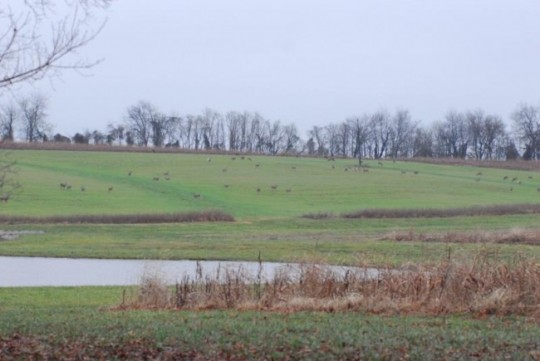Hunting Timber versus Row Crops
Filed under: Deer Hunting, Hunting Blog
I’m returning from hunting in Kentucky as I write this. I hunted a friend’s property that is primarily timbered. Timbered means that much of the sun’s light doesn’t reach the ground during the growing season as it’s captured by the trees’ canopy. The lack of sun reaching the dirt means food production for deer (and many other forms of wildlife) is limited.
Limited food means limited numbers of deer compared to habitat types like row crops (corn and soybeans) or the prairie. In these areas most of the sun’s light (energy) reaches the dirt or at least the crop’s canopy which is within a deer’s reach most of the year. More food, more deer. I like hunting where there are more deer (I call that a target rich environment!).
Another advantage of hunting in row crop or prairie areas is visibility. Less than 20 miles from where I was hunting on the timbered property, I toured a corn and soybean (row crop) farm. It was a well managed farm with excellent crop production and cover strips for wildlife and erosion control. It was a great example of farming for profit while managing a percentage of the land primarily for wildlife (farming and wildlife can co-exist while profits are maintained). I counted more than 300 deer during a brief tour!
The weather, date, etc., was the same as while I was hunting on the timbered property. With three of us hunting, we saw fewer than 20 deer from the stand during three days of hunting.
I felt very confident I could have grabbed my bow and Muddy stand and harvested a good buck within a day or two at the grain production farm. It was very obvious where the deer were bedding and feeding, and where they were traveling from one to the other.
Many other folks have made this same observation. This is why hunters migrate annually to the row crop areas of the Midwest to hunt and most hunting shows are filmed there. It’s simply easier to pattern deer in areas where most of the land base is open and visible. In addition the cultivated crops are outstanding food for deer and allow them to express most of their genetic potential.
That’s not to say that hunting in the timber isn’t fun. My place is mostly timbered and I enjoy hunting there. However, I usually spend several months trying to pattern and harvest a buck. I can usually accomplish the same goal in much less time when hunting areas where row crops are the dominate habitat type.
I enjoy hunting anywhere – but know my chances for success are better where there’s lots of sunlight reaching the dirt!
Growing Deer together,
Grant




